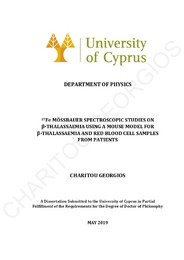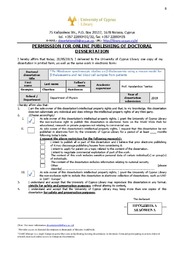| dc.contributor.advisor | Tsertos, Charalambos | en |
| dc.contributor.author | Charitou, Georgios H. | en |
| dc.coverage.spatial | Κύπρος | el |
| dc.coverage.spatial | Cyprus | en |
| dc.creator | Charitou, Georgios H. | en |
| dc.date.accessioned | 2019-08-07T09:26:20Z | |
| dc.date.available | 2019-08-07T09:26:20Z | |
| dc.date.issued | 2019-05 | |
| dc.date.submitted | 2019-05-20 | |
| dc.identifier.uri | http://gnosis.library.ucy.ac.cy/handle/7/52400 | en |
| dc.description | Includes bibliographical references (p. 132-137). | en |
| dc.description | Number of sources in the bibliography: 76 | en |
| dc.description | Thesis (Ph. D.) -- University of Cyprus, Faculty of Pure and Applied Sciences, Department of Physics, May 2019. | en |
| dc.description | The University of Cyprus Library holds the printed form of the thesis. | en |
| dc.description.abstract | Η β-θαλασσαιμία είναι μια κληρονομική αναιμία που προκαλείται από μεταλλάξεις του γονιδίου β‑σφαιρίνης. Επηρεάζει πολλαπλά όργανα και συνδέεται με σημαντική νοσηρότητα και θνησιμότητα. Σε αυτή την εργασία χρησιμοποιήθηκε η φασματοσκοπία Mössbauer (MS) για τη μελέτη της θαλασσαιμίας, χρησιμοποιώντας για πρώτη φορά ένα μοντέλο θαλασσαιμικού ποντικού καθώς και δείγματα αίματος από ασθενείς με β-θαλασσαιμία.
Αρχικά μελετήθηκε η χρησιμότητα του θαλασσαιμικού μοντέλου και στη συνέχεια η συγκέντρωση του 57Fe σε ποντίκια άγριου τύπου C57BL / 6 και ετερόζυγα β-θαλασσαιμικά αυξήθηκε μέσω μακροχρόνιας γαστρεντερικής απορρόφησης δίαιτας εμπλουτισμένης με 57Fe. Δείγματα αίματος, καρδιάς, συκωτιού, νεφρών, σπλήνας και εγκεφάλου συλλέχθηκαν από ποντίκια ηλικίας 1, 3, 6 και 9 μηνών και φάσματα MS πάρθηκαν σε θερμοκρασίες 80Κ. Τα β-θαλασσαιμικά ποντίκια, σε αντίθεση με τα άγριου τύπου, έδειξαν μειωμένα επίπεδα αιμοσφαιρίνης στο αίμα τους ως αποτέλεσμα της αναιμίας, καθώς και σημαντική ποσότητα σιδήρου υπό μορφή φερριτίνης, η οποία μειωνόταν με την ηλικία των ποντικιών. Αυτό μπορεί να αντικατοπτρίζει την μείωση του αριθμού δικτυοερυθροκυττάρων που αναφέρεται στη βιβλιογραφία. Οι εναποθέσεις σιδήρου υπό μορφή φερριτίνης στην καρδιά και στον εγκέφαλο των θαλασσαιμικών ποντικών βρέθηκαν ελαφρώς αυξημένες ενώ σημαντικές ποσότητες σιδήρου υπό μορφή φερριτίνης βρέθηκαν στα νεφρά, το συκώτι και τον σπλήνα. Οι νεφρικοί ιστοί των θαλασσαιμικών ποντικών βρέθηκαν να έχουν ~ 16 φορές περισσότερο σίδηρο υπό μορφή φερριτίνης από τα ποντίκια άγριου τύπου και ~10 φορές στο συκώτι. Επιπλέον, στους σπλήνες βρέθηκε σίδηρος υπό μορφή αιμοσιδηρίνης και δισθενής σίδηρος υψηλού spin μη συνδεδεμένος με αίμη. Η διπλέτα της φερριτίνης που βρέθηκε στα όργανα, μπορούσε να χωριστεί περαιτέρω σε δύο υπο-διπλέτες που αντιπροσωπεύουν την εσωτερική και την επιφανειακή δομή του μεταλλικού πυρήνα της φερριτίνης. Ο σίδηρος επιφανείας βρέθηκε να επικρατεί στις καρδιές και τους εγκεφάλους όλων των ποντικιών και στα νεφρά των ποντικιών άγριου τύπου. Φερριτίνη πλούσια σε εσωτερικό σίδηρο βρέθηκε να επικρατεί στα νεφρά των θαλασσαιμικών ποντικών, στο συκώτι και στο σπλήνα. Η αναλογία εσωτερικού προς επιφανειακού σιδήρου ήταν αυξημένη σε όλα τα θαλασσαιμικά δείγματα.
Τα φάσματα MS από τα ερυθρά αιμοσφαίρια των ασθενών με θαλασσαιμία έδειξαν την ύπαρξη σημαντικών ποσοτήτων σιδήρου που υπό μορφή φερριτίνης, κυρίως στα δείγματα από ασθενείς με ενδιάμεση β-θαλασσαιμία, όπου το 82% από αυτούς εμφάνισε αυτό το σύμπλοκο. Ταυτόχρονα, όπως εκτιμήθηκε με εξετάσεις MRI, οι ασθενείς με ενδιάμεση β-θαλασσαιμία βρέθηκαν να έχουν υψηλότερη συγκέντρωση σιδήρου στο συκώτι (LIC) σε σύγκριση με τους ασθενείς με μείζονα β-θαλασσαιμία, αν και είχαν κατά μέσο όρο περίπου το ήμισυ των επιπέδων φερριτίνης στον ορό αίματος. | el |
| dc.description.abstract | β-thalassemia is an inherited anaemia caused by mutations of the β-globin gene. It affects multiple organs and is associated with considerably morbidity and mortality. In this work, Mössbauer spectroscopy (MS) was used for the study of thalassaemia disease, utilising for the first time a thalassaemic mouse model, as well as blood samples from β-thalassaemia patients.
The usefulness of a thalassaemic mouse model was initially validated and subsequently the concentration of 57Fe in wild-type C57BL/6 and heterozygous β-thalassaemic mice was significantly increased through long-term gastrointestinal absorption of 57Fe enriched diet. Samples of blood, hearts, livers, kidneys, spleen and brains were collected from mice at 1, 3, 6 and 9 months of age and MS spectra were acquired at 80K. The β-thalassaemic mice, in contrast to the wild-type ones, showed reduced haemoglobin levels in their blood as a result of anaemia, as well as significant amounts of ferritin-like iron, which decreased with mouse age. The later might reflect the pattern of reticulocyte count reduction reported in the literature. Ferritin-like iron depositions in the heart and the brain of the thalassaemic mice were found to be slightly increased while significant amounts of Ferritin-like iron were found in the kidneys, liver and spleen. The renal tissues of the thalassaemic mice were found to have ~16 times more Ferritin-like iron than the control equivalents and their livers ~10 times. Furthermore, haemosiderin and non-haem-high spin Fe(II) iron was found in their spleens. The Ferritin-like iron doublet, found in the organs, could be further separated into two sub-doublets representing the inner and surface structure of ferritin’s mineral core. Surface iron sites were found to be predominant in the hearts and brains of all mice and in the kidneys of the wild-type ones. Ferritin rich in inner iron sites was predominant in the kidneys of the thalassaemic mice, in the livers and in the spleens. The inner-to-surface iron sites ratio was elevated in all thalassaemic samples.
The MS spectra from the red blood cells of the thalassaemia patients showed the existence of significant amounts of ferritin-like iron, mainly in the samples from the β-thalassaemia intermedia patients, where 82% of them showed evidence of this iron complex. At the same time, β-thalassaemia intermedia patients were found to have higher Liver Iron Concentration (LIC) when compared to the β-thalassaemia major patients, as assessed by MRI exams, although they had on an average about half the serum ferritin levels. | en |
| dc.format.extent | xxii, 182 p.: charts, diagrs, tables; 30 cm. | en |
| dc.language.iso | eng | en |
| dc.publisher | Πανεπιστήμιο Κύπρου, Σχολή Θετικών και Εφαρμοσμένων Επιστημών / University of Cyprus, Faculty of Pure and Applied Sciences | |
| dc.rights | info:eu-repo/semantics/openAccess | en |
| dc.rights | Open Access | en |
| dc.subject.lcsh | Thalassemia | en |
| dc.subject.lcsh | Mössbauer spectroscopy | en |
| dc.subject.lcsh | Blood cells -- Diseases | en |
| dc.title | 57Fe Mössbauer spectroscopic studies on β-thalassaemia using a mouse model for β-thalassaemia and red blood cell samples from patients | en |
| dc.title.alternative | Φασματοσκοπικές μελέτες 57Fe Mössbauer στη β-θαλασσαιμία χρησιμοποιώντας ένα β-θαλασσαιμικό μοντέλο ποντικιών και δείγματα ερυθρών αιμοσφαιρίων από ασθενείς | el |
| dc.type | info:eu-repo/semantics/doctoralThesis | en |
| dc.contributor.committeemember | Αρχοντής, Γεώργιος | el |
| dc.contributor.committeemember | Όθωνος, Ανδρέας | el |
| dc.contributor.committeemember | Κωστρίκης, Λεόντιος | el |
| dc.contributor.committeemember | Δούβαλης, Αλέξιος | el |
| dc.contributor.committeemember | Archontis, Georgios | en |
| dc.contributor.committeemember | Othonos, Andreas | en |
| dc.contributor.committeemember | Kostrikis, Leondios | en |
| dc.contributor.committeemember | Douvalis, Alexios | en |
| dc.contributor.department | Πανεπιστήμιο Κύπρου, Σχολή Θετικών και Εφαρμοσμένων Επιστημών, Τμήμα Φυσικής | el |
| dc.contributor.department | University of Cyprus, Faculty of Pure and Applied Sciences, Department of Physics | en |
| dc.subject.uncontrolledterm | β-ΘΑΛΑΣΣΑΙΜΙΑ | el |
| dc.subject.uncontrolledterm | ΦΑΣΜΑΤΟΣΚΟΠΙΑ 57Fe MÖSSBAUER | el |
| dc.subject.uncontrolledterm | β-THALASSAEMIA | en |
| dc.subject.uncontrolledterm | 57Fe MÖSSBAUER SPECTROSCOPY | en |
| dc.identifier.lc | RC641.7.T5H3 2019 | en |
| dc.author.faculty | Σχολή Θετικών και Εφαρμοσμένων Επιστημών / Faculty of Pure and Applied Sciences | |
| dc.author.department | Τμήμα Φυσικής / Department of Physics | |
| dc.type.uhtype | Doctoral Thesis | en |
| dc.rights.embargodate | 2019-05-20 | |
| dc.contributor.orcid | Tsertos, Charalambos [0000-0001-5966-343X] | |


